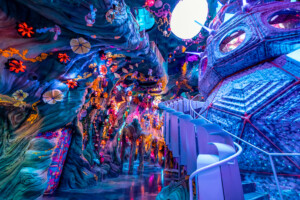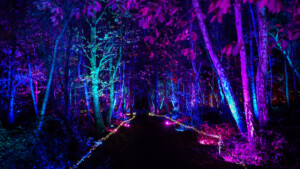Clara Rice, Assistant Project Manager at Jack Rouse Associates (above), takes a trip along the Kentucky Bourbon Trail.
Related: Jim Beam Brings New JRA Designed Distillery Experience to the Bourbon Trail
Rolling green hills laced with the white fences of thoroughbred stables. The smell of wheat and barley mingled with the freshness of bluegrass. The taste of a smooth, caramel-colored beverage as enjoyed from a rocking chair. These are the ingredients of Kentucky’s Bourbon Trail.
Kentuckians have been distilling bourbon (named after one of Kentucky’s original counties, when the state was still part of Virginia) since the 1700s, and today 95% of all bourbon is made in Kentucky. The state’s distilleries produce 300 brands of whiskey, and all of the states’ major distilleries are within 75 miles of each other, owing mostly to the limestone-enriched water that flows through the region. In 1999, these distillers formed the Kentucky Bourbon Trail® so that visitors could witness the broad spectrum of Kentucky bourbon production. The tour includes seven distilleries, with an eighth opening in Fall  2013, and in total the Trail welcomes 2.5 million annual visitors from 25 countries. Guests have their Bourbon Trail passport stamped at each location, and upon receiving all seven stamps can mail in their passport for a free T-shirt. A separate Bourbon Trail Craft Tour showcases seven smaller distilleries specializing in handcrafted brands, and visitors to all seven receive a classic Kentucky julep cup.
2013, and in total the Trail welcomes 2.5 million annual visitors from 25 countries. Guests have their Bourbon Trail passport stamped at each location, and upon receiving all seven stamps can mail in their passport for a free T-shirt. A separate Bourbon Trail Craft Tour showcases seven smaller distilleries specializing in handcrafted brands, and visitors to all seven receive a classic Kentucky julep cup.
Because touring seven bourbon distilleries (and tasting rooms) is a daunting (and dangerous) enterprise, for the purposes of this article, we’ll visit Woodford Reserve, Maker’s Mark and Jim Beam. The three tours, and the processes they illustrate, are very similar, in large part because federal law poses strict guidelines on bourbon production methods. While all bourbons are whiskies, not all whiskies are bourbons.
To be called bourbon:
- The whiskey must be made in the United States.
- It must contain at least 51% corn.
- It must be all-natural (water, grains and yeast).
- It cannot be distilled at more than 160 proof (or 80% alcohol).
- It cannot enter the barrel at more than 125 proof.
- It must be aged in new, charred-oak barrels.
- It cannot be bottled at less than 80 proof.
All three locations offer (or will soon offer) cafés and gift shops; all offer roughly one-hour, $7-8 guided tours; all allow photography and all take guests through the process of bourbon production from fermenting and distilling to barreling and bottling. The differences in the tours stem from the unique methods, propriety technologies and decades of craftsmanship each distillery employs to produce their distinctive brand (or brands) of bourbon.
Woodford Reserve Distillery

Nestled in the heart of Kentucky horse country, the Woodford Reserve Distillery, originally built in 1865, is a National Historic Landmark. While the buildings, which are considered the few remnants of the “Scotch-Irish” architectural style, are nearly 150 years old, Woodford Reserve itself is fairly new, with its first batch produced only 17 years ago. Due to the American prohibition and bourbon’s decline in favor in the 1970 s, the distillery changed hands several times. Brown-Forman, who sold the distillery in 1971, re-purchased it from the buyer in 1993 and re-furbished it for production. Woodford Reserve produces two, small-batch bourbons – Woodford Reserve Select and Woodford Reserve Double Barreled.
s, the distillery changed hands several times. Brown-Forman, who sold the distillery in 1971, re-purchased it from the buyer in 1993 and re-furbished it for production. Woodford Reserve produces two, small-batch bourbons – Woodford Reserve Select and Woodford Reserve Double Barreled.
Once they purchase their tour ticket, guests await their tour in the visitor’s center, which offers graphics and push button interactives concerning the history of bourbon, the history of the distillery, and an introduction to the bourbon making process. The tour begins in a presentation room, where a guide takes a deeper dive into Woodford Reserve’s history and distributes the headsets that will be used throughout the tour (the bourbon making process can get a bit noisy, so the guide speaks through a wireless microphone). It is also during this presentation that the guide explains the five flavor sources that comprise bourbon: water, grain, fermentation, distillation and aging. He also introduces Woodford Reserve’s proprietary production methods, which, as he points out, have won Woodford Reserve gold medals at every major spirits competition.
Once the guests have their headsets, they board a bus for the warehouse that houses the fermentation, distillation and bottling areas. There the guide displays the grain mix, which is 72% corn, with the remainder being rye and barley. Woodford Reserve uses the oldest strain of yeast in bourbon country (from 1920), which ensures a degree of consistency within each batch. After explaining the grain composition of the bourbon, the guide takes guests to the cooker. The first ingredient for the cooker is backset mash, or mash used from the previous day’s batch. Again, this backset mash is used to ensure consistency. Water is then added, followed by the corn, rye and ba rley. The entire cooking process takes approximately six hours. After the mash is cooked, 400 gallons of yeast are added. The mash is then fermented for 6-7 hours in oak vats, which our guide proudly pointed out is twice the fermentation time of any other brand.
rley. The entire cooking process takes approximately six hours. After the mash is cooked, 400 gallons of yeast are added. The mash is then fermented for 6-7 hours in oak vats, which our guide proudly pointed out is twice the fermentation time of any other brand.
After fermentation, the alcohol is separated from the mash via a distillation process. The remaining mash goes to a neighboring farmer for his cattle. Our guide joked that because the mash still has 5% alcohol, the cattle could be considered “pre-marinated”. Woodford Reserve uses copper pot stills for its distillation process, in part for authenticity reasons and in part because it creates a smoother bourbon by removing the sulfites in the alcohol. Woodford is the only whiskey distillery in the US, and the only bourbon distillery anywhere, to triple distill its product, which the company believes magnifies the flavors before it reaches its threshold of 158 proof. Guests are given the opportunity to smell the pungent “new whiskey” before it enters the barrel. The guide explained that 70% of the flavor of the bourbon comes from the barrel, and unlike Jim Beam and Maker’s Mark, Woodford Reserve manufactures its own barrels. Also in this room, guests notice a plaque representing the distillery’s “Premium Selection” program. For the low price of $10, 000, participants can blend their own batch and receive eighteen 1-liter monogrammed bottles of their special concoction, as well as the barrel. They also have their name engraved onto the plaque.

The final stop on the tour before the tasting is the Aging Room. Woodford Reserve is the only distillery with a barrel run, so they can be rolled directly from the warehouse to the barrel stacks. Unlike other distilleries, the barrels are not rotated throughout the aging room to regulate their temperature – the room is instead climate controlled. The guide explained that due to evaporation, five percent of the barrel’s contents are lost each year. Since the bourbon ages for six to seven years, that evaporation equates to a loss of 30%-35%. The evaporated liquid is water, so the bourbon goes into the barrel at 110 proof and comes out at 140. Water is added to the barreling process to get the bourbon to its “bottle proof” of 90.4. Patrolling the aging room is Jeremiah, the distillery’s trusted guard cat. This room marks the conclusion of the tour, and upon returning to the visitor’s center, guests are offered a small tasting of Woodford Reserve Select and a bourbon infused chocolate (known as a “bourbon ball”). They are invited to keep their tasting glass as a souvenir of their visit.
Maker’s Mark Distillery

Another National Historic Landmark, Maker’s Mark Distillery is located seventy-three miles down the road in another pastoral setting. Maker’s Mark distinguishes itself as the only distillery of the three in which the guest can walk between all of its tour buildings. The tour begins in the historic house owned by Mr. William (“Bill”) Samuels, Jr., who purchased the distillery in 1953. Samuels’ goal was to reinvent the bourbon recipe and make it smoother. He developed this recipe by baking seven loaves of bread, each with a different grain combination. He determined that the one without rye tasted best, so he replaced this typically used bourbon grain with soft red winter wheat. The name for the bourbon came from Samuel’s wife, who argued that because Bill was making a new kind of whiskey, his brand needed its own distinctive mark.
the distillery in 1953. Samuels’ goal was to reinvent the bourbon recipe and make it smoother. He developed this recipe by baking seven loaves of bread, each with a different grain combination. He determined that the one without rye tasted best, so he replaced this typically used bourbon grain with soft red winter wheat. The name for the bourbon came from Samuel’s wife, who argued that because Bill was making a new kind of whiskey, his brand needed its own distinctive mark.
.jpg)
When you walk into Maker’s Mark’s cooking and distilling room, you can instantly smell the winter wheat. Maker’s cooks its backset mash, water and new mash for 3 hours and ferments it for 3 days. The mixture then ferments in 100-year-old, 9, 600 wood vats. Guests are invited to taste the fermenting mash, which has a flavor and texture profile akin to sauerkraut mixed with oatmeal. The mash is again removed and sent to the local farmer, and the liquid is distilled in a five-story still. In Maker’s barrelhouse, the barrels start at the top of the aging room and move their way down throughout the aging process to ensure even temperature (since heat rises). Although all barrels are aged over four years, the determination of whether a barrel of bourbon is ready for bottling is made by taste, not necessarily by time. The unique bottle design and distinctive melted red wax top are trademarked by the distillery. The tops are hand-dipped at the rate of 20 bottles per minute, and special edition bottles with non-red tops are considered extremely collectible.
Maker’s Mark offers three tastings at the conclusion of its tour, as well as another delicious, high-calorie bourbon ball. The first tasting is of Makers White Whiskey. Like the “new whiskey” at Woodford, this spirit is not considered bourbon, as it has not yet touched a barrel. It is in these tasting rooms where the visitors really get to interact with each other, and oftentimes it becomes a source of comic relief. When asked by our tour guide, Betty, what they smelled from the White Whiskey, one guest eagerly replied, “I smell college.” Next up was Makers Regular, bottled at 90 proof. The difference between the amber, aged product and its colorless predecessor was obvious – this tasting was much smoother, hitting the front of the tongue versus the back of the throat. Spiciest of the three tastings was Makers 46. After the barrel finishes its initial aging process, 10 French oak staves (charred to a “level 46”, hence the name), are inserted into the barrel, which is then aged for an additional 3-5 months before being bottled at 94 proof. When asked whether they had tasted Makers 46 before, the same wisecracking visitor answered, “it’s what gets me through my day, Betty.”
Jim Beam American Stillhouse

The final stop on the mini-tour was the Jim Beam American Stillhouse. Unlike Maker’s Mark and Woodford Reserve, the Jim Beam American Stillhouse has stayed in the same family for 215 years, and that sense of tradition is evident from the moment the guest walks through the visitor center doors. High upon the wall is a family tree of the seven generations of Beam distillers, and adjacent is a short, looping video profiling this legacy. Guests can buy their tour ticket here, although advanced reservations are recommended (all tours were sold out the day of our trip). Behind and above the ticket desk is a two-story  gift shop, as well as digital scrapbooks of photos from Beam family history.
gift shop, as well as digital scrapbooks of photos from Beam family history.
Jim Beam produces over five times as many individual brands as the other two distilleries, so the tour offers a glimpse into both the small and large batch production processes. Guests board a shuttle bus that takes them to their first stop, and during their journey, their tour guide (in this case, Kyle) warns them that they may be asked to participate in the bourbon making process. Guests are first introduced to the Kentucky water that is the foundation of Jim Beam bourbon, via a small stream running under the warehouse floor. Next they actually run their fingers through the corn, rye and barley before heading to the small batch fermentation area, where they can again taste a small sampling of the fermenting mash (this one was newer and thus less sour than Makers). The guests head outside to the barreling porch, where one lucky guest can hammer a bung (or cork) into the hole of a barrel. Next stop is the control room, which monitors the location of each drop of whiskey on the property.
The tour then shifts to the large batch fermentation tank, consisting of nineteen 45, 000-gallon fermenters. Guests are invited to stick their nose in the tank but should be prepared for a heat and odor that will literally throw their head back. Another hands-on opportunity awaits them at the barreling porch, where they can dump out a fully-aged barrel and watch the whiskey travel to the bottling area. Back inside, they can see the small batch bottling line, which is accented with colorful cartoon graphics depicting each of the Beam Family distillers.
 Quality control is highly emphasized on this tour. After visiting the small batch bottling line, the guide takes guests to a special holding area and explains that two bottles from every order are kept back for 2.5 years in case there are any issues with the batch. After this holding period, the bottles are given to employees to take home and enjoy. Bottles range from airport size all the way to the 4.5-liter bottles that are shipped to Australia, where Jim Beam is the #1-selling spirit. The tour ends with a visit to large batch bottling, which produces 300 bottles per minute, or roughly 8, 000 cases per day. Throughout the entire experience, the guide emphasizes the family traditions and commitment to craftsmanship that have become synonymous with the brand.
Quality control is highly emphasized on this tour. After visiting the small batch bottling line, the guide takes guests to a special holding area and explains that two bottles from every order are kept back for 2.5 years in case there are any issues with the batch. After this holding period, the bottles are given to employees to take home and enjoy. Bottles range from airport size all the way to the 4.5-liter bottles that are shipped to Australia, where Jim Beam is the #1-selling spirit. The tour ends with a visit to large batch bottling, which produces 300 bottles per minute, or roughly 8, 000 cases per day. Throughout the entire experience, the guide emphasizes the family traditions and commitment to craftsmanship that have become synonymous with the brand.
The most unique part of the Jim Beam tour is the tasting room. Guests are introduced to the Enomatic, a dispensing technology only previously employed for wine. Each guest is given a card with an embedded microchip. They insert the card into the machine, put their glass under the tap of the brand they want to taste, press the corresponding button and receive their tasting. Of the 15 brands available for tasting, guests are limited to two per federal law. The Enomatic machines provide an innovative tasting experience, but they can also be rolled away to accommodate private events.
The newly conceptualized tour, which opened in October 2012, has led to a 60% jump in visitation to the distillery. Jim Beam expects 160, 000 visitors in 2013 (up from 100, 000) and 200, 000 in 2014. The distillery now offers 11 tours daily, and when asked what effect the new tour has had on brand recognition, our guide Kyle said that those who had not visited the distillery for twenty years are now coming back, and they are returning again and again. “One guy has brought back 25 people in the last three months alone, ” he said. “We’re not only seeing an increase in repeat visitation, we’re also seeing a younger demographic, so we get to introduce bourbon to a new generation.” Fred’s Smokehouse, a café named after Fred Noe, current Master Distiller and great-grandson of Jim Beam, will open in Fall 2013, offering another amenity to the Jim Beam American Stillhouse and Distillery Tour experience.
Distinctive architecture, only-here experiences, beautiful surroundings, rich stories and quality craftsmanship. All three of these distilleries offer all this and more. So smile and sip: you’re in Bourbon Country.
IF YOU GO
Best Time to Go:
Anytime but August, when the heat is stifling and the distilleries annually shut down production.
 Distillery Information:
Distillery Information:
Complete Bourbon Trail Info – www.kybourbontrail.com
Woodford Reserve – 7855 McCracken Pike, Versailles, KY www.woodfordreserve.com
Maker’s Mark – 3350 Burkes Springs Road, Loretto, KY www.makersmark.com
Jim Beam American Stillhouse – www.americanstillhouse.com
For Cheap Lodging and a Non-distilled Diversion:
My Old Kentucky Home State Park
235-acre park that includes Federal Hill mansion, which was built by US Senator John Rowan in 1795. “My Old Kentucky Home” refers to the famous, turn-of-the century American minstrel song (and now State Song of Kentucky) written by Stephen Foster, America’s first composer and Rowan’s cousin. An informative, 25-minute tour of the home is $7. The park also includes a golf course, a 39-site campground (with RV and primitive sites) and an amphitheater featuring seasonal productions of “The Stephen Foster Story” musical. The park is within walking distance of Heaven Hill Distillery and a short drive from Willett Distillery and Jim Beam American Stillhouse.
For Absorption:
Old Talbott’s Tavern
107 West Stephen Foster, Bardstown, KY www.talbotts.com
An historic tavern in the heart of Bardstown, which was recently proclaimed the Most Beautiful Small Town in America, this 18th century tavern features traditional Kentucky fare like hot fried green tomatoes, country fried steak and well, pretty much fried anything, as well as the usual pub staples. Their site also features a bourbon bar with live music and a five-room bed and breakfast.
Mammy’s Kitchen
114 N. 3rd St., Bardstown, KY
The quintessential southern greasy spoon, served up with a “howdy y’all” from the waitress, quaint décor and delicious breakfasts.
Author’s Full Disclosure: JRA designed and produced the Jim Beam New American Stillhouse and Distillery Tour for Beam, Inc., which owns Jim Beam and Maker’s Mark. JRA also provided complete design and production for the Jack Daniel’s Distillery Visitor Center. Jack Daniel’s is owned by Brown-Forman, which also owns Woodford Reserve.
Image credit: All images except the T Jeremiah Beam Collage Mural, the exterior of the Woodford Distillery and the Woodford visitor centre are credited to Andrew E. Hlavac.











